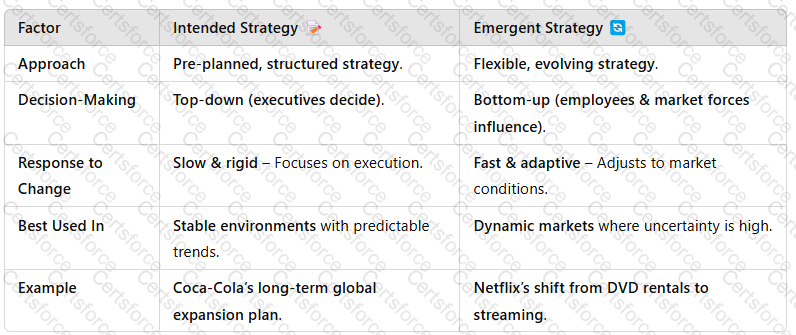Evaluation of Intended Strategy vs. Emergent Strategy
Introduction
Strategy formation is acritical processthat determines how businesses achieve their objectives. Two contrasting approaches exist:
Intended Strategy– Adeliberate, planned approach, where management defines a clear course of action.
Emergent Strategy– Aflexible, adaptive approach, where strategy evolves in response to external changes.
Both approaches have advantages and constraints, and organizations oftencombine bothto maintain strategic direction while adapting to market uncertainties.
1. Intended Strategy????(Planned Approach to Strategy Formation)
Definition
Anintended strategyis astructured, pre-planned approachwhere an organizationsets long-term goals and develops a roadmap to achieve them.
✅Key Characteristics:
Clearly defined mission, vision, and objectives.
Top-down decision-makingwith structured implementation plans.
Focus onforecasting, market research, and competitor analysis.
????Example:
McDonald’s follows an intended strategyby expanding its franchise model using structured business plans and operational guidelines.
Advantages of Intended Strategy
✔Provides a clear vision and direction– Ensures all departments align with corporate goals.✔Supports long-term resource allocation– Helps in budgeting and investment planning.✔Enhances risk management– Allows organizations to prepare for potential challenges.✔Ensures consistency– Ideal forstable industries with predictable market conditions.
Constraints of Intended Strategy
❌Inflexible in dynamic markets– Struggles with unforeseen changes (e.g., economic crises, technology shifts).❌Can lead to missed opportunities– Focuses on execution rather than adaptation.❌Slow response time– Delays decision-making in fast-changing industries.
????Key Takeaway:Intended strategy works best instable environmentswhere long-term planning can be executedwithout major disruptions.
2. Emergent Strategy????(Flexible & Adaptive Approach to Strategy Formation)
Definition
Anemergent strategyis aresponsive, flexible approachwhere businessesadapt their strategies based on real-time changesin the market.
✅Key Characteristics:
Strategy emerges fromtrial and error, experimentation, and learning.
Encouragesbottom-up decision-making, allowing employees to contribute.
Focuses onshort-term flexibility and continuous adjustments.
????Example:
Amazon’s move into cloud computing (AWS)was an emergent strategy, as it originally started as an online bookstore but adapted to market opportunities.
Advantages of Emergent Strategy
✔Highly adaptable– Allows businesses to pivot in response to market shifts.✔Encourages innovation and experimentation– Promotes new ideas and flexible problem-solving.✔Reduces risk of failure– Companies can adjust strategiesbefore fully committing to large-scale investments.✔Works well in unpredictable environments– Essential for industries liketechnology, fashion, and e-commerce.
Constraints of Emergent Strategy
❌Lack of clear direction– Can create confusion in organizations with no defined strategic goals.❌Resource inefficiency– Constant adjustments may lead to wasted time and investment.❌Difficult to scale– Unstructured decision-making can cause inconsistencies.
????Key Takeaway:Emergent strategy isideal for fast-changing industrieswhere adaptability is more valuable than rigid planning.
3. Comparison: Intended Strategy vs. Emergent Strategy
 A screenshot of a computer
Description automatically generated
A screenshot of a computer
Description automatically generated
Key Takeaway:Most successful organizationsblend both approaches, usingintended strategy for stabilityandemergent strategy for adaptability.
4. Conclusion
Bothintended and emergent strategieshave strengths and weaknesses.
✅Intended strategyisbest for structured, long-term growthin stable industries.✅Emergent strategyallows forrapid adaptationin volatile markets.✅Most businesses use a combinationof both approaches, balancingplanning with flexibility.
Byintegrating intended and emergent strategies, organizations canmaintain stability while responding effectively to market changes.
Submit